Horse-riding Stance (qi ma shi)
 |
In
this stance you stand with your feet parallel, a little wider than
shoulder width apart and pointing forward. Your torso and head face
forward and your spine is neutral between the head and the pelvis. You
distribute your body's weight equally between each foot and leg. Bend
your knees and sit back, as though sitting down on a chair. Bend your
knees only as far you can sustain in a relaxed way throughout the
stance practice. Over time, as you develop leg strength you will be
able to take a deeper stance. However, do not go lower than when your
thigh is parallel to the ground.
In the horse-riding stance, you extend your arms in front of you at
about shoulder height, elbows bent slightly, and the forearms rotated
to face each other, hands open. |
Bow-and-arrow stance (gong jian shi)
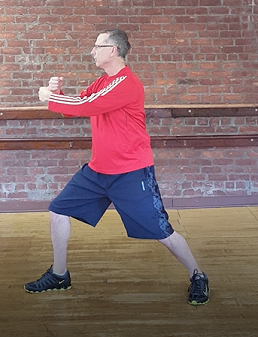 |
To make the transition from the horse-riding stance to the
bow-and-arrow stance, you pivot to the side. Pivot on the heel of the
leg that will become the front leg, and on the ball of the foot that
will be to the rear, so your feet are at a forty-five degree angle from
pointing forward. Point each knee in the same direction as the toes of
the corresponding foot. If a line were drawn laterally between your
legs, the toes of the front foot and the heel of the rear foot would
just touch it.
Simultaneously with the shift of feet and legs, shift your torso and
head ninety degrees so you face toward the front foot and shift your
weight forward slightly, so that sixty percent of your weight is on the
front leg and foot and forty percent is on the rear. The rear hip is
slightly opened.
At the beginning of the movement draw your elbows in towards your body,
and then as your torso turns it carries the arms with it, as you push
the arms forward, rounded and crossed at the wrists. When the
transition to the bow-and-arrow stance is complete, you have closed
each hand into a fist and crossed your arms at the wrists, with the arm
from the same side as the forward leg behind the other.
To return to the horse-riding stance, you push from the front foot,
turning on the heel of the front leg and the ball of the rear, so that
your feet in the horse-riding stance are again parallel. |
Empty leg stance (xi shi)
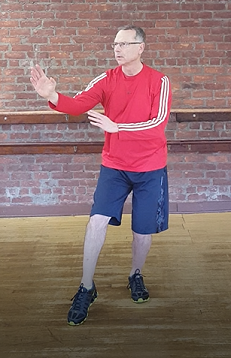 |
To make the transition to empty stance, pivot what will be your rear
foot forty five degrees, shift your weight to that foot as you pivot
the hips, torso, shoulder and head forty five degrees, as you complete
the move of all your weight to the rear leg. The empty leg is drawn in
slight, resting lightly on the toes and slightly rotated in at the hip
to cover the groin.
As you move your shoulders the arms shift. As you complete the
transition the hand opposite to the empty leg is open and at about nose
height. The other hand reaches to below the upper arm's elbow. Both
hands are in line with the nose, forward knee and the toe.
To make the transition back to horse riding stance, step with the empty
foot to the original position point forwards and slowly return fifty
percent of your weight to that foot. |
Stretching stance (pu tui shi)
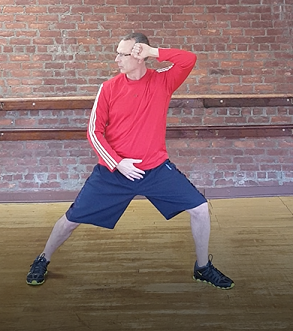 |
Sink slowly on one crouched leg while you slide the other foot along
the ground until that leg is straight (although the knee is not
locked). Both feet must be flat on the ground. The back is straight and
almost upright. Your head faces the stretched leg. If you cannot crouch
completely down without lifting a heel off the floor or bending, go
only as low as you are able with good form.
The hand opposite the straight leg is raised, fist pointing out at the
temple. The other hand is palm inward at the dan tien. |
Single-leg stance (du li shi)
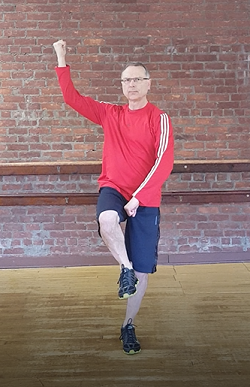 |
To make the transition from horse riding stance, slowly transfer all
your weight to one leg. Move the empty leg in close. As you rise
slightly, pivot your torso and shoulders forty five degrees as you
raise the empty leg with toe up until the thigh is parallel to the
floor, turned slightly at the hip to protect the groin. The supporting
leg is bent slightly. A straight leg is too rigid. In the stance the
arm on the same side as the empty leg is raised above the head, with
fist pointed inwards. The other hand is in a fist finger side pointed
forward.
To return to the horse riding stance, slowly lower on the standing leg
until you reach the right height, as you also lower your arms. Step so
your feet are shoulder width apart and return your weight to
fifty-fifty, with torso facing forward, and feet parallel. |
|
Forty sixty stance (si lui shi)
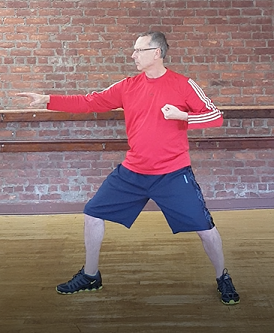
|
Explanation
needed... |
Twisted leg stance (zou pan shi)
 |
Explanation needed ... |
Seventy thirty stance (san chi shi)
Picture needed...
|
Explanation needed... |






